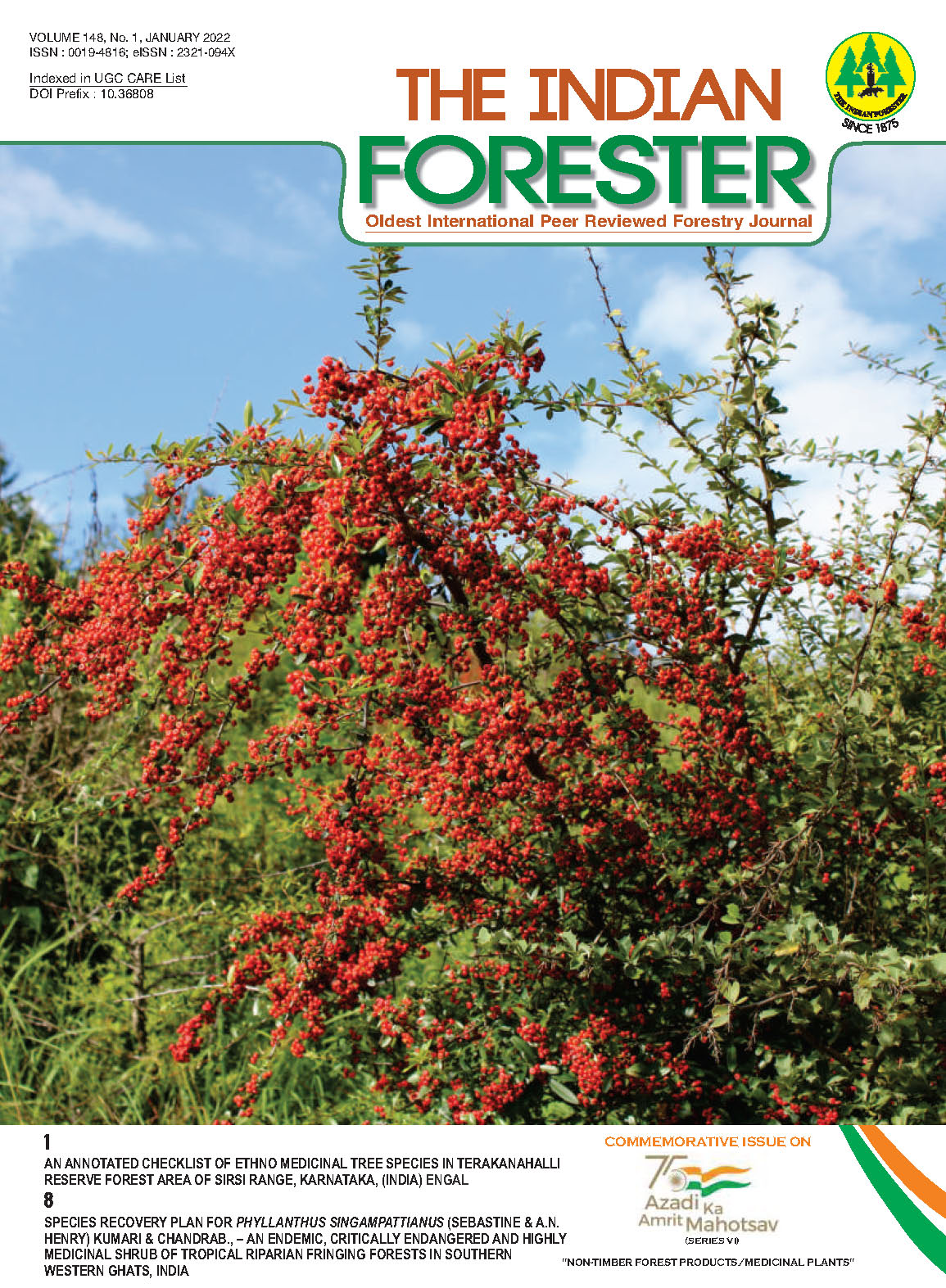Do Invasive Species have the Medicinal Potential ?
DOI:
https://doi.org/10.36808/if/2022/v148i1/158058Keywords:
Ethonomedicine, Invasive Species, Sikkim Himalaya.Abstract
The reported twenty two invasive species representing Asteraceae (9 plant specimens), Malvaceae (2 plant specimens), Euphorbiaceae (2 plant specimens), Solanaceae (2 plant specimens) and one species each in Verbenaceee, Rosaceae, Urticaceae, Cyperaceae, Caryophyllaceae, Polygonaceae and Oxalidaceae are studied in order to understand the medicinal uses.
The information obtained from the survey revealed that these invasive species were in use for different purposes such as Lantana camara L. (Family-Verbinaceae) used as anti-pest, Crassocephalum crepidioides (Benth.) S. Moore and Sonchus oleraceus L. for controlling blood sugar and Drymaria cordata (L.) Willdenow ex Schultes and Oxalis corniculata L. for controlling anti-tumurous growth.
Interestingly, the trend of hill people found using Rumex nepalensis Spreng. and Pilea microphylla (L.) Liebmann, for settling the dislocated bones, likewise, another plant specimen, Ageratina adenophora (Sprengel) King and Robinson reported treating neurological disorder.
Thus, the paper deals the medicinal potentials of the plant specimens whether the invasive specimens possess the commercial viability.
References
Bown D. (1995). Encyclopaedia of Herbs and their Uses. Dorling Kindersley, London.
Brown W.H. (1920). Minor Products of Philippine Forests. Bureau of Forestry, Manilla.
Burkil H.M. (1985). The Useful Plants of West Tropical Africa. Royal Botanic Gardens, Kew.
Chevallier A. (1996). The Encyclopedia of Medicinal Plants, Dorling Kindersley, London.
Chopra R.N., Nayar S. L. and Chopra I.C. (1986). Glossary of Indian Medicinal Plants, Council of Scientific and Industrial Research, New Delhi.
Duke. J.A. and Ayensu E.S. (1985). Medicinal Plants of China, Algonac, Michigan.
Durate M.C.T., Figueira G.M., Sartoratto A., Rehder V.L.G. and Delarmelina C. (2005). Anti-Candida activity of Brazilian medicinal plant, J. Ethnopharmacol. 97: 305-311.
Fogarty J.E. (1990). Barefoot, A Doctors Manual. Running Press, Philadelphica.
Grierson A.J.C. and Long D.G. (1983). Flora of Bhutan, Vol 1(1), Edinburgh, Royal Botanic Garden, Edinburgh.
Grieve A. (1984). Modern Herbal. Penguin.
Hara H. (1966). The Flora of Eastern Himalaya, First Report, University of Tokyo, Japan.
Hara H. (1971). The Flora of Eastern Himalaya, Second Report, The University of Tokyo Press, Japan.
Hooker J.D. (1872-1897). The Flora of British India, Vol. 1-7, L. Reeve & Co., Kent, London.
Irvine F.R. (1961). Woody plants of Ghana. London, Oxford University Press.
Kirtikar K.R. and Basu B.D. (1933). Indian Medicinal Plants, Vol. 3, Pub. L.M. Basu, Allahabad.
Lust J. (1983). The Herb Book, Pub. Bantam books.
Maity D., Maiti G.G. and Chauhan A.S. (2018). Flora of Kanchenjunga Biosphere Reserve, Sikkim Botanical Survey of India, Kolkata, +834 pp.
Manandhar N.P. (1991). Medicinal plant-lore of Tamang tribe of Kabhrepalanchok District, Nepal, Economic Botany. 45: 58-71.
Manandhar N.P. (2002). Plants and People of Nepal, Timber Press, Oregon. ISBN.0-88192-527-6.
Mandal S.K., Boominathan R., Parimaladevi B., Dewanjee S. and Mandal S.C. (2005). Analgesic activity of methanol extract of Eupatorium adenophorum Spreng. Leaves, Indian Journal of Experimental Biology, 43(7): 662-663.
Moerman D. (1998). Native American Ethnobotany, Timber Press, Oregon.
Neffatti A., Ben Ammar R., Dijoux-Franca M.G., Ghedira K. and Chekir-Ghedira L. (2008). In-vitro evaluation of antibacterial, antioxidant, cytotoxic and apoptotic activities of the tubers infusion and extracts of Cyperus rotundus, Bioresour. Technol., 99: 9004 -9008.
Nima Z.A.M., Jabier M.S., Wagi R.I. and Hussain H.A.A. (2008). Extraction, Identification and Antibacterial activity of Cyperus oil from Iraqi C rotundus, Eng .& Technology, 26(1): 10.
Oliver-Bever B. (1986). Medicinal Plants in Tropical West Africa, Cambridge Cambridge, UK University Press, +200 pp.
Panda S.K. and Luyten W. (2018). Antiparasitic activity in Asteraceae with special attention to ethnobotanical use by the tribes of Odisha, India, Parasite, 25: 10.
Ruffo C.K., Birnie A. and Tengnas B. (2002). Edible Wild Plants of Tanzania. Regional Land Management Unit, Nairobi.
Sekhar K.C. (2012). Invasive Alien Plants of Indian Himalayan Region- Diversity and Implication, American Journal of Plant Science, 3: 177-184.
Shrestha B., Basnett H. and Pal P. (2015). Herbal Remedies Practised By Traditional Practitioners Of Nepali Tribe In Sikkim, UJPSR, 1(1): 51-53.
Singh G. and Kachroo P. (1976). Forest Flora of Srinagar. Bishen Singh Mahendra Pal Singh.
Stuart G.A. (1911). Chinese Materia Medica, Taipei, Southern Materials Centre.
Thomas E. Vandebroek I. and Damme P.V. (2007). What Works in the Field? A comparison of different interviewing methods in Ethnobotany with special reference to the use of photographs, Econ Bot., 61(200&): 376-384.
Tomimori K., Nakama S., Kimura R., Tamaki K., Ishikawa C. and Mori N. (2012). Antitumor activity and macrophage nitric oxide producing action of medicinal herb, Crassocephalum crepidioides. BMC Complementary and Alternative Medicine, 12(78): (21 June 2012).
Weiner M.A. (1980). Earth Medicine, Earth Food. Ballantine Books.
Yu J., Lei G., Cai L. and Zou Y. (2004). Chemical composition of C. rotundus extract, J. Phytochemistry, 65: 881-89.
Yingngam B., Supaka N. and Rungseevijitprapa W. (2011). Estrogen-like activities and cytotoxicity effects of Thai herbal medicines as natural ingredients in anti-ageing, J. Med. Plants Res., 5(31): 6832-6838.
Zhengyi W., Raven P. H. and Deyuan H. (1994). Flora of China, Science Press (Beijing) & Missouri Botanical Garden (St. Louis).
Downloads
Downloads
Published
How to Cite
Issue
Section
License
Unless otherwise stated, copyright or similar rights in all materials presented on the site, including graphical images, are owned by Indian Forester.





